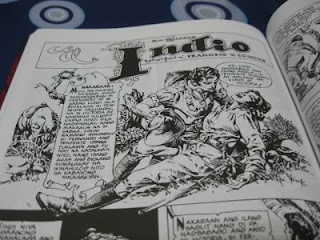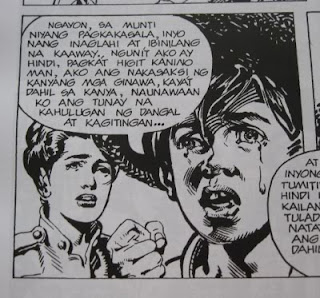There was a time in the History of Philippine Comics when a good artist is also a good writer at par with the rest of the comic book authors ever published abroad. We as Filipinos should be proud of this talented group, this legion, a pack, a cadre of gifted artists that once uplifted the level of artistry and storytelling in the printed form that became a major source of story for film scripts in the local movie industry at the time of the nation's freedom from the second World War, up to the First People Power Revolution of EDSA. The majority of those serious artists points to one direction, to one person--- a great Maestro, a source of inspiration that served as a guiding torch in time of darkness from the political indifference, materialism and greed that spawned Martial Law. His name is Francisco V. Coching.
If you still can't see it, think of Jose Rizal who used the same method to convey effectively his story of "Monkey & the Turtle" to tell a lesson and provide a moral and an intellectual consciousness to the Filipino youth of his own generation.

Today, it's a rarity to see a good, serious comic book writer who also draws his own story panel by panel and page by page, from the thumbnail sketches up to the penciling, cleanup, inking, lettering, and printing stages (Frank Miller is a popular example, but I can't think of other author right now who is very good in writing and drawing his own story). This current age of Photoshop that almost killed the traditional system of illustration is used for sorting, editing, and restoration for us to finally see again and treasure the classic style of comic book art. And I tip my hat to Gerry, Zara, the Coching Family and Vibal Foundation for finally being able to show to the kids--- this global generation a once lost art that's truly Filipino by heart and by soul.

Buy this book, enjoy the classic story of a sequel novel (originally serialized in Pilipino Komiks circa 1953) about the son of a Spanish Viscountess and a Filipino rebel and appreciate the artwork. Study Mang Koko's style of realistic illustration and dynamism if you're a serious artist. You will learn something very useful, useful as a potent weapon to add in your hidden artistic arsenal.
For today's kiddos, you may not consider the book worthy to be included in your pricey collection of manga and grafiction titles but if you ask me, El Indio is more valuable than any manga you highly treasured. Throw away, or better sell those Hentai collection and replace them with a better collection starting with El Indio.
Your future children will appreciate it.
some memorable scenes:


Rating: 5 punglo out of 5
Genre: Philippine Historical Fiction, Graphic Novel
If you still can't see it, think of Jose Rizal who used the same method to convey effectively his story of "Monkey & the Turtle" to tell a lesson and provide a moral and an intellectual consciousness to the Filipino youth of his own generation.
Today, it's a rarity to see a good, serious comic book writer who also draws his own story panel by panel and page by page, from the thumbnail sketches up to the penciling, cleanup, inking, lettering, and printing stages (Frank Miller is a popular example, but I can't think of other author right now who is very good in writing and drawing his own story). This current age of Photoshop that almost killed the traditional system of illustration is used for sorting, editing, and restoration for us to finally see again and treasure the classic style of comic book art. And I tip my hat to Gerry, Zara, the Coching Family and Vibal Foundation for finally being able to show to the kids--- this global generation a once lost art that's truly Filipino by heart and by soul.
Buy this book, enjoy the classic story of a sequel novel (originally serialized in Pilipino Komiks circa 1953) about the son of a Spanish Viscountess and a Filipino rebel and appreciate the artwork. Study Mang Koko's style of realistic illustration and dynamism if you're a serious artist. You will learn something very useful, useful as a potent weapon to add in your hidden artistic arsenal.
For today's kiddos, you may not consider the book worthy to be included in your pricey collection of manga and grafiction titles but if you ask me, El Indio is more valuable than any manga you highly treasured. Throw away, or better sell those Hentai collection and replace them with a better collection starting with El Indio.
Your future children will appreciate it.
some memorable scenes:
Rating: 5 punglo out of 5
Genre: Philippine Historical Fiction, Graphic Novel

Hi! Great review! Were you able to go to the book launch? There's a wonderful exhibit of Coching's work with Botong Francisco's.
ReplyDeleteSadly I didn't make it to the National Museum for the launch of Mang Koko and Botong's coffee table books but if the exhibit is ongoing til january, maybe I can sneak in for a peek. There's news right now that Atlas Publishing released FCV's previous work on Pilipino Komiks (1954) titled Lapu-Lapu. I'm not sure about the quality of paper since I heard it just costs 120 pesos in NBS. It's still, a collector's item.
ReplyDelete